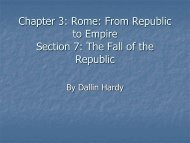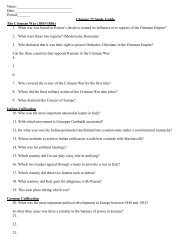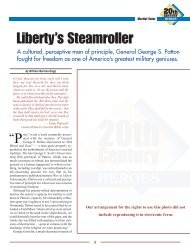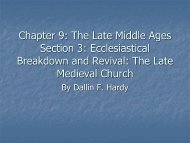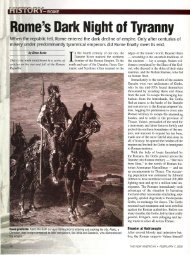The Lindbergh Baby Kidnapping Mystery - Home
The Lindbergh Baby Kidnapping Mystery - Home
The Lindbergh Baby Kidnapping Mystery - Home
You also want an ePaper? Increase the reach of your titles
YUMPU automatically turns print PDFs into web optimized ePapers that Google loves.
AP Images<br />
<strong>The</strong> trial’s injustices — involving the<br />
prosecution, judge, and some police officers<br />
— suggest a powerful hand at work.<br />
<strong>Lindbergh</strong> was popular, but lacked the<br />
wealth and political influence to compromise<br />
an entire justice system. Could<br />
the kidnapping, and eventual smearing of<br />
<strong>Lindbergh</strong> as perpetrator, both trace to the<br />
<strong>Lindbergh</strong>s’ enemies?<br />
In his new book <strong>The</strong> <strong>Lindbergh</strong> <strong>Baby</strong><br />
Kidnap Conspiracy, Professor Alan Marlis,<br />
who taught for 35 years at City University<br />
of New York, believes James P.<br />
Warburg was behind the kidnapping. A<br />
prominent banker and member of President<br />
Franklin D. Roosevelt’s “brain trust,”<br />
Warburg is perhaps best remembered for<br />
telling a Senate subcommittee in 1950 we<br />
would have world government “by conquest<br />
or consent.” He was the son of Federal<br />
Reserve architect Paul Warburg.<br />
Marlis’ book, currently available only<br />
from the McNally Jackson Bookstore in<br />
New York City, is clearly a self-published<br />
manuscript, but demonstrates extensive<br />
research. Marlis describes a context of<br />
sudden deaths for enemies of the FDR-<br />
Federal Reserve crowd:<br />
• Walter Liggett, speechwriter for <strong>Lindbergh</strong>,<br />
Sr., was murdered in 1935 — a case<br />
never solved.<br />
• In 1936, Louisiana politician Huey<br />
Long, possibly FDR’s biggest reelection<br />
threat, was assassinated — an incident still<br />
controversial.<br />
• Louis McFadden, the Fed’s chief con-<br />
.heemerican.com<br />
gressional critic, survived two attempts on<br />
his life before dying suddenly, also in 1936.<br />
• After triggering the Great Depression,<br />
“establishment” bankers wanted Roosevelt<br />
elected as President in 1932 to spawn an<br />
era of government borrowing, erosion of<br />
the Constitution, and moves toward world<br />
government. <strong>Lindbergh</strong>’s father-in-law,<br />
Dwight Morrow, now Republican Senator<br />
for New Jersey, was touted as a possible<br />
presidential candidate. In October 1931,<br />
Morrow, 58 and fit, attended a charity dinner<br />
hosted by Lehman Brothers — heavy<br />
backers of FDR. (Herbert Lehman was<br />
Roosevelt’s Lieutenant Governor in New<br />
York and signed the papers extraditing<br />
Hauptmann to New Jersey.) After the dinner,<br />
Morrow returned home — and died<br />
that night. Thus vanished a remaining<br />
hope for the Republicans, whom newspapers<br />
blamed for the Depression.<br />
In 1932, one man still posed a threat<br />
to FDR’s election — Charles <strong>Lindbergh</strong>.<br />
Lindy was too young constitutionally to<br />
run for President, but his popularity was<br />
so universal that his active presence alone<br />
might have kept Republican hopes alive.<br />
But five months after Morrow’s sudden<br />
death, <strong>Lindbergh</strong>’s baby was murdered —<br />
effectively removing the grieving father<br />
from the political scene. Some of the links<br />
Marlis draws to James Warburg:<br />
• <strong>The</strong> <strong>Lindbergh</strong>s and Warburgs had<br />
what Marlis calls a “blood feud.” In 1913,<br />
Charles <strong>Lindbergh</strong>, Sr. tried to stop creation<br />
of the Federal Reserve — which Paul<br />
A new boo blames hm: James P. Warburg sits<br />
before the Senate Banking Committee in April<br />
1935, about two months after Hauptmann was<br />
sentenced. <strong>The</strong> friction between Warburg and<br />
Charles <strong>Lindbergh</strong> echoed that of their fathers.<br />
Warburg, its first vice-chairman, had designed.<br />
In 1917, <strong>Lindbergh</strong> tried to have<br />
Warburg, as well as FDR’s uncle Frederic<br />
Delano, impeached from the Federal Reserve<br />
Board. According to Marlis, <strong>Lindbergh</strong><br />
“Jew-baited” Warburg at the Fed<br />
chairman hearings; Paul told his son, and<br />
the insult wasn’t forgotten.<br />
• In 1941, the fathers’ feud continued<br />
between the sons. James Warburg helped<br />
found and finance the Freedom First Committee<br />
to oppose <strong>Lindbergh</strong>’s America<br />
First Committee, debated <strong>Lindbergh</strong> at<br />
Madison Square Garden, and publicly denounced<br />
him.<br />
• Paul Warburg died less than two<br />
months before the kidnapping.<br />
• <strong>The</strong> police had suspected the crime<br />
was an inside job. <strong>The</strong> governess in James<br />
Warburg’s household was the sister of the<br />
Morrows’ seamstress, Marguerite Junge,<br />
who knew about the <strong>Lindbergh</strong>s’ change<br />
of plans. Junge’s alibi for the kidnapping<br />
night: She was “out riding” with Red<br />
Johnsen — boyfriend of the baby’s nurse.<br />
• In April 1932 (just after the kidnapping<br />
and ransom payment), James Warburg<br />
took a two-month trip to Europe.<br />
• Warburg’s estate was in Greenwich,<br />
Connecticut — the town where the very<br />
first <strong>Lindbergh</strong> ransom gold certificate<br />
was passed, by a well-dressed woman at<br />
a bakery. <strong>The</strong> cashier, checking the serialnumber<br />
list, exclaimed it was <strong>Lindbergh</strong><br />
ransom money. <strong>The</strong> woman snatched it<br />
back and ran outside into a chauffeured<br />
sedan — which police unsuccessfully<br />
searched for.<br />
Dr. Marlis makes an interesting case,<br />
but also seems to draw some unnecessary<br />
inferences from coincidences. Warburg ordering<br />
the kidnapping cannot be proven.<br />
As with Hauptmann, fairness should negate<br />
“convicting” him on circumstantial<br />
evidence.<br />
This article could not address many<br />
facets of this still-debated case. For those<br />
interested in more, good starts are Anthony<br />
Scaduto’s Scapegoat, Lloyd Gardner’s<br />
balanced <strong>The</strong> Case That Never Dies, and<br />
www.lindberghkidnap.proboards.com. n<br />
39





